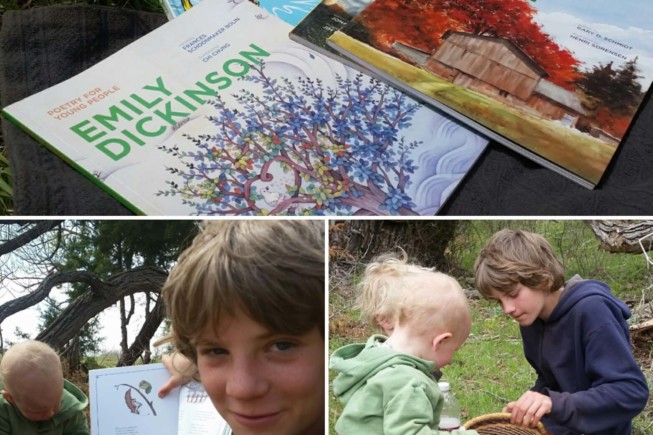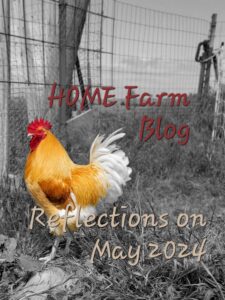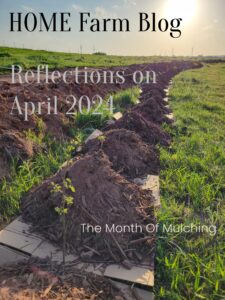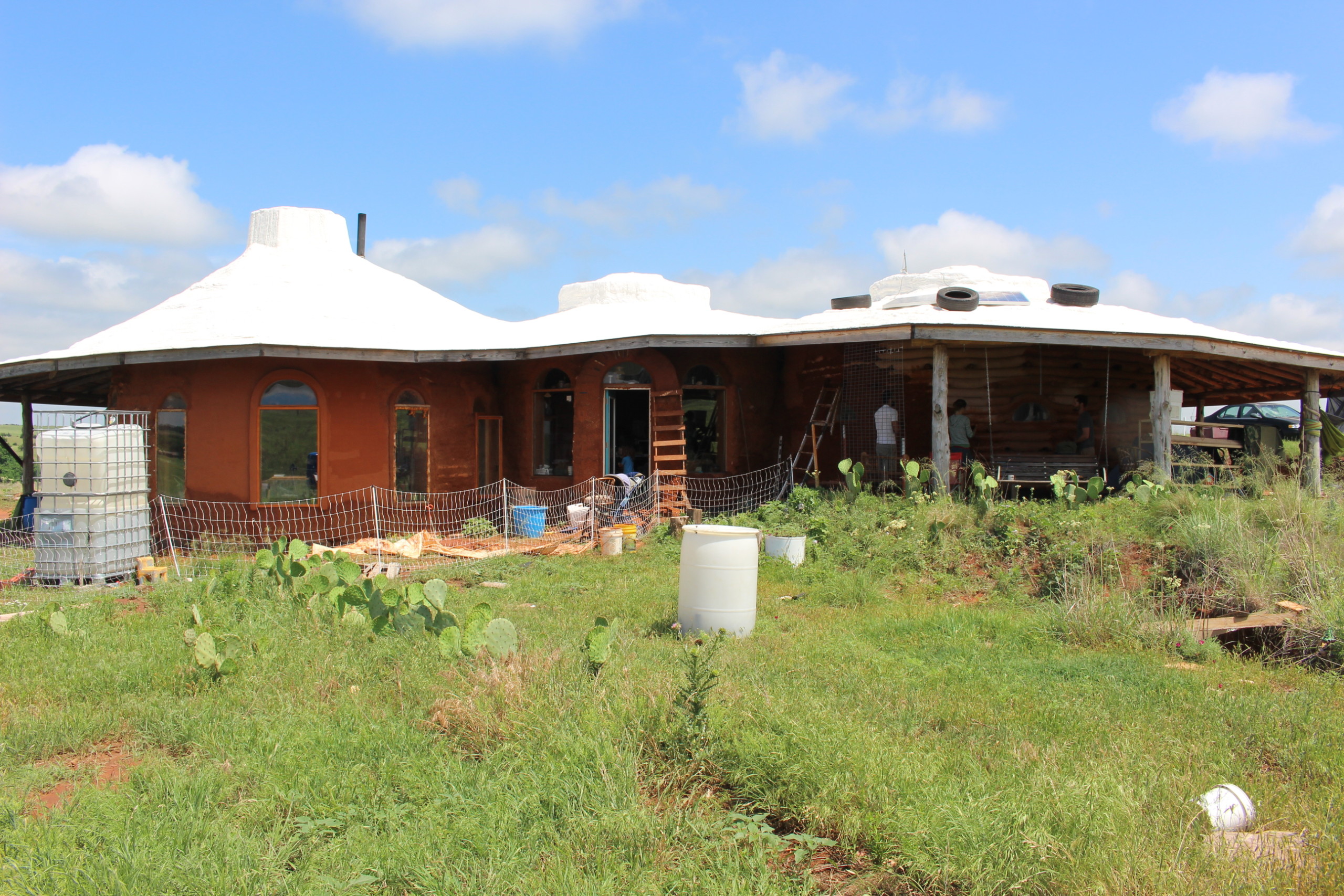The absence of April showers equals a lack of flowers, unfortunately. We finally had some wintry mix on the morning of the 7th this month. The kids’ excitement quickly vanished as it melted. Sorry boys, no snow this year. And we’ve only had 3 rains, none of which accumulated more than a half-inch. I’m hoping it’s just a delay, and not a foreshadowing of perpetual drought. Despite the lack of rain, our garden looks promising.
The Garden
Early in the month we jumped on an opportunity to do some plant shopping. We found a discount raspberry in a bin that was labeled blueberry and couldn’t resist. We also chose several varieties of peppers, some hot and some sweet. I’ve resolved to buying peppers in the plant stage because I just can’t seem to get them started from seed. Two Rosemary plants, two mints, and a lavender also made it into the cart. And then I had a vision… A beautiful 20×4 foot sunken bed, filled to the brim with cute little zig-zag leaves and plump, deep red strawberries, bordered only by hungry snacking children on picnic blankets with their books. So we bought a bunch of strawberries. Some plants, and some crowns. We’ll be heading back to the store for more plants because the crowns weren’t a crowning achievement. We stuck some bush beans in their place to pick up some of the slack.
We were quickly reminded that the chickens would need to be relocated and fences would need reorganized to keep the feathered beasts from eating my precious fruits and seeds. This is what we came up with:
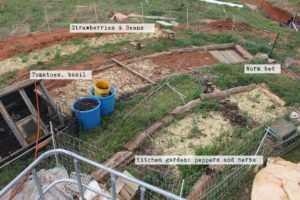
As per the Biointensive method, our sunken beds are 4 feet across; ideal for being able to reach to the middle without stepping in the beds themselves. The beds curve with the house, the first bed is 20 feet long. It is the kitchen garden with peppers, herbs, garlic, and rosemary, as well as cilantro and onions. The second bed is the one we gave the char and chicken, double dig treatment. It has tomatoes and basil, carrots, and some flowers. On the far right end of that middle bed is the worm bed, covered by a board to keep it moist. And the last bed is the newest one. It hasn’t had any soil building treatment other than compost and not enough mulch. It has strawberries from plants and crowns as well as bok choy, broccoli, spinach, carrots, and bush beans. The three beds are surrounded by our movable fence and the chicken coop makes a corner border.
You may remember me mentioning that our soil is less than ideal. The structure is good; it’s a sandy loam with excellent drainage, and the pH is around 7. But it is lacking in fertility and is prone to becoming hard as a rock. So this is what we’ve done to increase the soil health:
Biochar. I mentioned this soil-building practice in previous blogs. In a nutshell, char holds microbiology when it has been “charged.” Last spring, we covered the garden bed with ~6 inches of crushed char.
Vermicompost. Our worm friends have been producing the headiest castings over the last year. We’ve simply fed them kitchen scraps and watered them occasionally. We had them in a kiddie pool for the winter and just moved them into the garden in a hole in one end. Aaron also added some prickly pear cactus pads to see how they break down. I am terrified that the entire worm bed and compost contents will forever have mean cactus spines but he thinks they will break down sooner than later.
Chicken Manure. We set the chicken tractor on top of the garden bed and left it there all winter. The chickens have been scratching, mixing, and fertilizing the char and soil.
Double Digging. After moving the chicken coop over, we sifted the bigger chunks of char out and left the smaller ones. Then we double dug the bed to loosen the very lower areas of soil where roots often simply stop. Loosening this soil allows water to penetrate deeper and to retain moisture longer. For more information on double digging, organic gardening and beyond look into John Jeavon’s Biointensive Method.
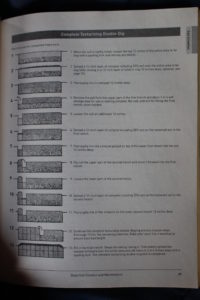
Compost and Mulch. Any smart gardener will tell you that compost is the key to optimal soil health. But it is alive and needs mulch to keep it from drying out. We have added about 2 cups of rich vermicompost to each of our plants when transplanting. We also add that vermicompost to garden areas before seeding.
Life with a 1 Year Old
The little guy is walking now! He is fast. He feels a little more powerful and independent; a little. About 70% of my time spent by the stove and sink, there is a little whiny barnacle attached to my leg. 20% of the time he is a raccoon, rummaging through the trash. The remaining 10% of the time he will sit and babble while playing with the measuring cups I have given him. Such is life with a 1 year old.
This month hasn’t afforded a lot of house building time. We’ve had dentist appointments, art classes, a speech by the 6th grader, speech therapy appointments for Mason, and laundry trips every 3-4 days. Sometimes I wonder if it’s worse for the environment to use throw-away diapers or to drive to the laundromat twice a week to wash the cloth ones(and everything else). Though I’m pretty sure the former is worse.
Water
Since Earth Day occured this month, let’s talk about water. Have you ever monitored your household water usage? Have you ever thought about how much water is required to produce daily items like disposable diapers, toilet paper, a pair of jeans, or your smartphone? That’s 9 gallons per diaper, 37 gallons per roll of butt-wipe, 1800 gallons to grow enough cotton to produce one pair of jeans, and 3190 gallons of water to make your phone. In fact, the average American family’s water footprint (including these everyday items on top of showers, dishes, and laundry) is 583 gallons per day!
That leads me to assess our water footprint. One of the biggest surprises for me in building an earthbag home was the amount of water we used. We use water virtually everywhere we use dirt. The dirt in the bags had to contain the right amount of water to tamp nicely and cure correctly. Each batch of cob, or fat plaster, requires about 5 gallons of water in mixing and application. We’ve made no less than 200 batches of that stuff. Our soil cement floors used lots of water. The paint we use on the walls is half water. But 100% of this water came from the sky. Okay, we hauled water from a public water thingy one time. 500 gallons. But most of it went onto the garden.
If you think about all the water used in the manufacture of lumber, the water used for poured concrete, production of vinyl siding, shingles, drywall, carpet, etc, it would become obvious that building with earth uses a tiny fraction.
In celebration of Mother Earth this year (though every day is earth day around here) we loaded a picnic basket with some lunch, some nature-related poetry books, and one of my favorites, The Lorax, to the tree line. We were down in a valley, out of the wind and the sun came out from behind the clouds intermittently and warmed our skin. It was simply lovely.
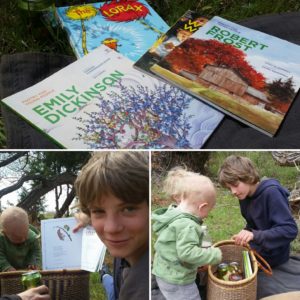
Batteries
And in keeping with the subject of sustainability, I’ll tell you about the next phase of installing the power system. Aaron has been poring over the forums and product descriptions of several batteries. A lot of people don’t think about batteries when they imagine a home solar system, but they are a huge part of the system. Literally. Aaron was describing the amount of space we’ll need in our little utility closet and it takes up like, most of the space. Once you have harvested the energy from the sun, you have to have somewhere to store it.
Aaron has nearly made up his mind on the Winston 700Ah 3.2v cell LiFePO4 battery. Since we’re studying the Periodic Table, I can tell you that this means Lithium Iron Phosphate. The rest is what I think I understand when he breaks down the battery jargon for me. His plan is to wire 16 cells (that means plus to minus) in series to make a 52 volt battery. This would create a 35Kw maximum storage. He’s been reading these lithium iron batteries don’t like to be fully charged, they will last much longer if you “keep em between the knees” whatever that means. Using a charge controller, one can set the charge to stay between 80% capacity and never to discharge below 20%.
The 21kw of usable energy storage provided will be enough to run the house for 4-5 days without any solar input. The life expectancy of LiFePO4 batteries in our application is greater than 10 years. Aaron says he will be happy if they last that long. But, the internet seems to think with proper care they could last decades. A decade is 10 years. “Decades” is a really long time. Our PV (photovoltaic) system will produce 25Kw on a perfect day, which means 4 Kw will be “extra.” This excess power production will divert to the water heater. Remember I said they don’t like to be kept full. We just “might” have to burn some power, turn up the music, buy a deep freeze, a washer, a dryer! We have quite a list of all the things we will power when we get our batteries hooked up. Let’s don’t get ahead of ourselves.
Interior Work
While I feel like I’ve been cobbing like mad, it’s really only been about one tarp-full each day when we’re here. Therefore, I have only completed the back wall of the west room. But it’s complete! The darker areas are still drying.
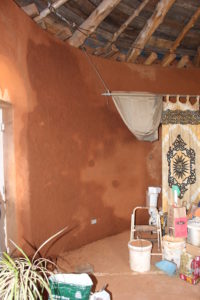
And it’s ready for plaster. I also plastered a big section of the pantry. It is so close to being ready! I can just imagine the walls lined with shelves of food, canning supplies, seeds we’ve saved. You know, prepper supplies and the like. Patience, young homesteaders.
More Work to Come
Next month we will begin Operation Beautify the Exterior! So far we have removed the hideous pink foam board in the big window and cobbed in the plexi-glass. Good start. Consider this the before picture!
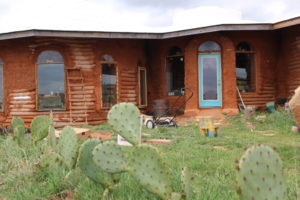
Books of the Month:
Julius (11) is reading Fahrenheit 451 by Ray Bradbury as assigned reading. He had trouble with the concept of someone writing about the future from back in the 50’s. He’s got it figured out now. The parlor walls are reality TV and the seashells are earbuds. In his free time, he has worked his way through the Harry Potter series. This is the third time he’s read the series!
Aaron is reading the computer screen.
Mason (Almost 4) and I have just started the practice of Morning Time! A podcast called Your Morning Basket has inspired this new endeavor. The benefits of morning time are threefold:
Mason gets some one on one time with Mommy. This fills his cup so he is more pleasant to be around all day.
He gets a plethora of beautifully articulated language and exposure to brilliant authors, stories, artists, and illustrations. He also gets some practice recognizing and writing letters, though I don’t put much emphasis on this. We try to keep it light and filled with joy.
By creating the habit of being open-minded and learning in the morning, we are instilling him with this desire-to-learn attitude that he can carry through the rest of the day.
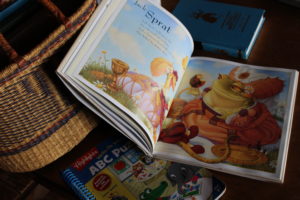
In our basket this month is a beautifully illustrated edition of Mother Goose by Scott Gustafson. We also read a children’s version of the original Little Mermaid by Hans Christian Anderson, and 2 of Roald Dahl’s books: The Magic Finger, and Esio Trot. We are excited to go see a ballet performance of The Little Mermaid in early May.
I haven’t had time for reading much. But on my bedside table is Writing in Flow, by Susan K. Perry. It has some really insightful tips and tidbits on getting into the creative process of flow. It was meant for writers but could work for most any art. I’ve also started memorizing some Shakespeare via How to Teach Your Children Shakespeare by Ken Ludwig. I’m excited to see if Julius likes it as much as I do.
Off to check for eggs! Happy Homesteading!
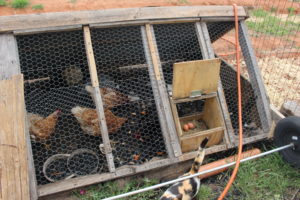
Average American Water Footprint https://www.watercalculator.org/
